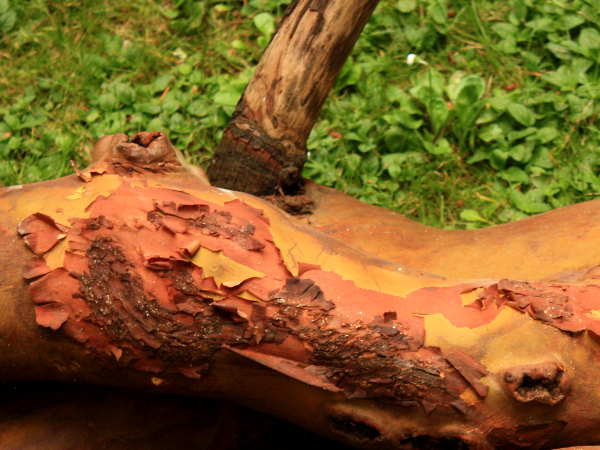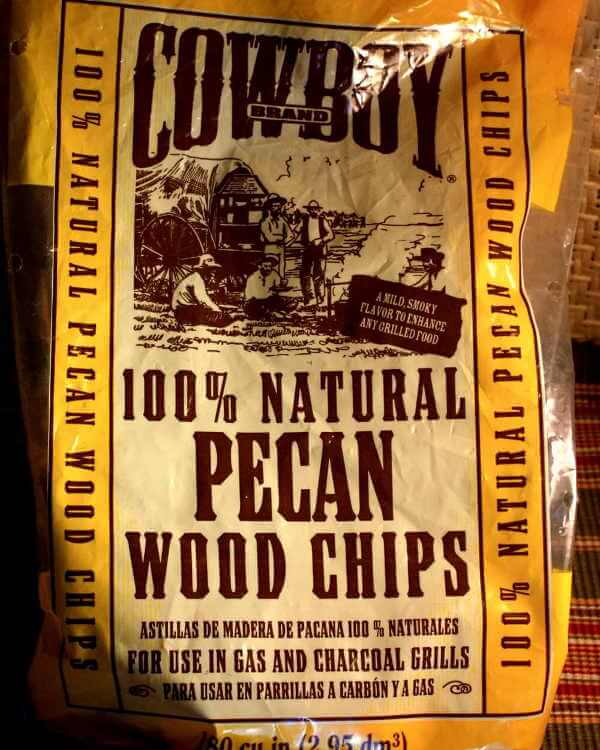Woods For Smoking Foods
I've been cooking with smoke for a several years now, and decided that listing all the woods for smoking that I've used, and my opinions of them, might be helpful.
 Madrone (or madrona) Log Sections Destined To Be Smoker Wood
Madrone (or madrona) Log Sections Destined To Be Smoker WoodMost of the smoking woods I use are from my own gatherings...fruit tree trimmings, firewood scraps and trees cut just for smoking food. I've learned a bit about using smoker wood over the years, and have heard some unusual thoughts about smoke woods, too.
Wood Types I've Used for Smoking
Here's the list, with comments...
Hickory
The last hickory I used for smoking is from a tree I cut down that was growing in the woods on the family farm. The trunk was about 8 inches in diameter, so I ended up with a lot of wood to use, and a lot to share.
I've always enjoyed the flavor hickory adds to meats. It's the classic flavor in bacon and barbecued pork ribs. I've found that it can be overdone, too. An excess of smoke can be strong tasting or turn the food bitter.
One strange comment I heard about hickory is that the smoke from the bark smells like Stetson cologne. I never got that impression, but I guess everybody's nose works a bit differently.
Mulberry
I've used quite a bit of mulberry wood. It's common here in South Central Kansas. I've even have a couple mulberry trees in my yard. Birds spread mulberry trees by eating the berries, then transporting the seeds.
There are two varieties I know of. One with purple berries, and another that has white berries. I know of the location of only one white berry bearing tree, which I plan to try a branch of for smoking someday.
The yellow colored wood is fairly mild flavored. I have heard that the best mulberry for smoking is from the female trees, which are the ones that bear fruit. Male trees don't have berries. I was also told that the sweeter the berries on a tree, the better the wood is for smoking. This is going to require further investigation on my part.
Red Oak
I've used this wood quite a bit, usually when smoking beef briskets and pork ribs. The flavor is not as rich as that of hickory. It also grows on the family farm near Kansas City. There are several there that have trunks almost 2 feet in diameter, reaching 75 to 100 feet into the sky. That would make for a lot of smoked brisket!
White Oak
Another native tree on the farm, these are much smaller than the red oaks. The flavor is similar, but can be a bit harsher than their red cousins. Squirrels and whitetails love the acorns from white oaks.
Walnut
You don't see this one listed too often as a wood used for smoking, but I've had great results with walnut. The wood I used had been dead for several years, with the small log lying on the forest floor. The flavor was very mild, with a slight resemblance to pecan wood chips.
Pecan
This is one of my favorite woods for smoking, and I use it for beef, pork and poultry. It's flavor can be a bit robust, so I'm careful that I don't use too much. I've heard that many have had great success using pecan shell for smoking meats, but that's something I've not tried.
Mesquite
This one has a strong flavor and is best used sparingly or in combination with other types of wood. I enjoy the flavor of mesquite when it's used on smoked beef ribs.
Madrone / Madrona
This wood is indigenous to the coastal areas of Northern California, Oregon and Washington state. Fresh cut madrone has a rather sweet, fruity smell. The smoke it produces is rather intense, somewhat similar to mesquite but not quite so harsh. I've used madrona on beef, pork and chicken and enjoyed the flavor and aroma of the smoke on all three meats.
Hickory Nut Husks and Shells
Another interesting nut to consider, especially if you have a hickory tree nearby.
Magnolia Wood
This is one I haven't tried, but there are some who swear that it imparts a really nice flavor to smoked meats.
More Woods for Smoking

Apple
Apple has a mild flavor, and it gives a beautiful brownish color to the foods exposed to its smoke. I've used this with about everything, but like it especially well for fish and poultry.
There are many varieties of apple tree, some producing sweet fruit and others tart fruit. I wonder if the smoke flavor characteristics of the trees is similar to their fruits? This might be worth some experimentation.
Cottonwood
This is another tree common to Kansas, and these get huge. The bark is thick and furrowed, and the leaves flutter in the constant Kansas winds. I also have two of these beasts in my yard. They provide some nice shade.
But they are messy, too. In the spring, cottonwoods drop these sticky things...not sure what they are, but I think they pollinate the seeds. They stick to everything, and leave a glue-like mess on anything they touch.
When the weather heats up in June and July, the cotton starts to fly. The seedpods burst open, letting the fuzzy seeds out to clog up air conditioner compressors and irritate eyes. Sometimes it looks like a snowstorm when the fuzz flies.
In late summer, the empty seed pods begin to fall, creating another cleanup opportunity. And fall brings the falling of the leaves. A hundred foot cottonwood tree has a lot of leaves.
Cottonwood is one of the mildest woods for smoking, with little flavor. It can be used for fish, and I believe that it would be good for long periods of cold smoking.
Grapevines
I recently tried grapevines for smoking a beef chuck roast. I got a whiff of the smoke as the roast was cooking, and it seemed pretty harsh...it stung the inside of my nose. But when the roast was done, the smoke flavor was fairly mild. I'll try grapevines again with some different foods.
The grapevines I used came from some Concord grapes that I pruned last month. I don't know if the vines from different varieties of grapes produce different flavored smoke, but I'd like to find out. Wild grape vines grow on the farm, too. I plan to add them to the types of smoker wood that I have used.
Another Option For Adding That Smoky Goodness To Your Meats
It's perfectly fine to use the fuel designed for pellet grills and smokers instead of wood chips of chunks when smoking food. These pellets are available made from a variety of different wood sources.
In fact, I'll be smoking a slab of baby back ribs tomorrow using a couple of handfuls of Traeger Apple Wood Pellets for the smoke.
Be Cautious When Trying New Types of Smoker Woods
Some plants are poisonous, oleander being one of them, and one you should never use. If you decide to experiment with different woods, be sure that you know exactly what it is before using it.
Others, although safe to use, impart intense flavor to foods and these must be used sparingly. Mesquite is one type of wood that should be used in small amounts.
- You Are Here: Home >
- Tips >
- Woods For Smoking Food
